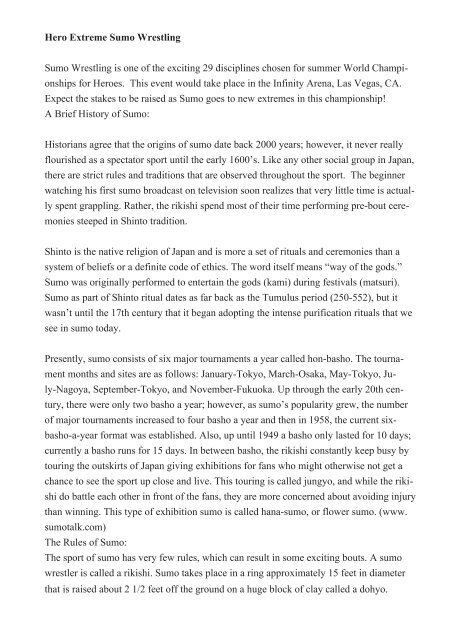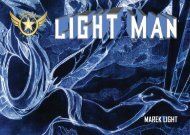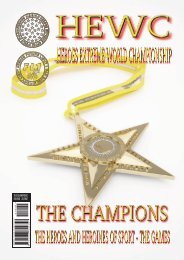HEWC Book
You also want an ePaper? Increase the reach of your titles
YUMPU automatically turns print PDFs into web optimized ePapers that Google loves.
Hero Extreme Sumo Wrestling<br />
Sumo Wrestling is one of the exciting 29 disciplines chosen for summer World Championships<br />
for Heroes. This event would take place in the Infinity Arena, Las Vegas, CA.<br />
Expect the stakes to be raised as Sumo goes to new extremes in this championship!<br />
A Brief History of Sumo:<br />
Historians agree that the origins of sumo date back 2000 years; however, it never really<br />
flourished as a spectator sport until the early 1600’s. Like any other social group in Japan,<br />
there are strict rules and traditions that are observed throughout the sport. The beginner<br />
watching his first sumo broadcast on television soon realizes that very little time is actually<br />
spent grappling. Rather, the rikishi spend most of their time performing pre-bout ceremonies<br />
steeped in Shinto tradition.<br />
Shinto is the native religion of Japan and is more a set of rituals and ceremonies than a<br />
system of beliefs or a definite code of ethics. The word itself means “way of the gods.”<br />
Sumo was originally performed to entertain the gods (kami) during festivals (matsuri).<br />
Sumo as part of Shinto ritual dates as far back as the Tumulus period (250-552), but it<br />
wasn’t until the 17th century that it began adopting the intense purification rituals that we<br />
see in sumo today.<br />
Presently, sumo consists of six major tournaments a year called hon-basho. The tournament<br />
months and sites are as follows: January-Tokyo, March-Osaka, May-Tokyo, July-Nagoya,<br />
September-Tokyo, and November-Fukuoka. Up through the early 20th century,<br />
there were only two basho a year; however, as sumo’s popularity grew, the number<br />
of major tournaments increased to four basho a year and then in 1958, the current sixbasho-a-year<br />
format was established. Also, up until 1949 a basho only lasted for 10 days;<br />
currently a basho runs for 15 days. In between basho, the rikishi constantly keep busy by<br />
touring the outskirts of Japan giving exhibitions for fans who might otherwise not get a<br />
chance to see the sport up close and live. This touring is called jungyo, and while the rikishi<br />
do battle each other in front of the fans, they are more concerned about avoiding injury<br />
than winning. This type of exhibition sumo is called hana-sumo, or flower sumo. (www.<br />
sumotalk.com)<br />
The Rules of Sumo:<br />
The sport of sumo has very few rules, which can result in some exciting bouts. A sumo<br />
wrestler is called a rikishi. Sumo takes place in a ring approximately 15 feet in diameter<br />
that is raised about 2 1/2 feet off the ground on a huge block of clay called a dohyo.






